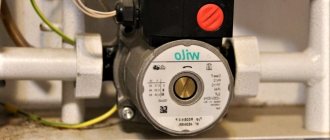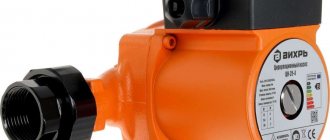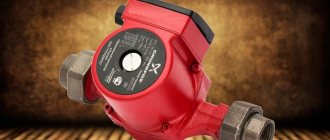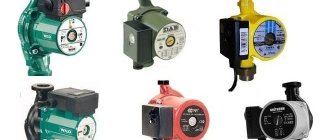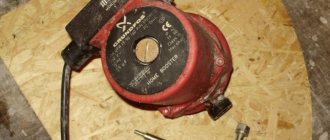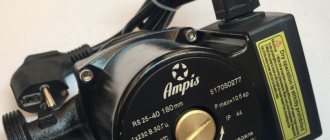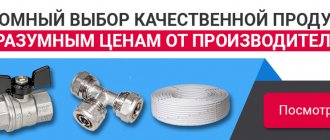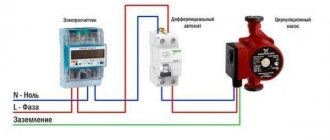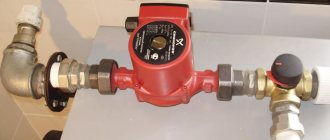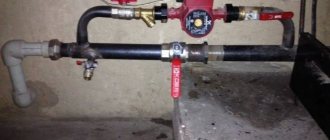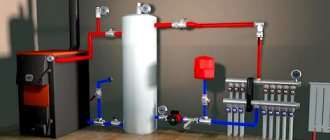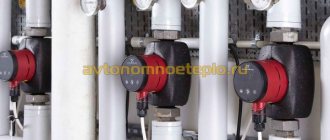It can be mounted on almost any convenient part of the system. This may be the “return” - a pipe entering the boiler. Pumps are also located at the very beginning of the supply pipe, both horizontally and vertically. Regardless of how the pump is equipped, its axis must be in a horizontal direction. With this arrangement, the unit operates without interruption for a long time and reliably. It is also worth mentioning that the mechanism installed horizontally demonstrates a higher resource and lasts much longer.
The example of installing the mechanism on the incoming pipe has one significant advantage. It lies in the fact that in this configuration the pump is cooled thanks to the coolant, which arrives at a lower temperature than when leaving the boiler. It is precisely this temperature regime that is attractive to owners, which forces them to install the pump on the “return”.
Types of open heating schemes
In an open heating system, the coolant moves in two different ways. The first option is natural or gravitational circulation, the second is forced or artificial stimulation from a pump. The choice of scheme depends on the number of floors and area of the building, as well as on the expected thermal conditions.
Natural circulation in heating
The gravitational system does not have any mechanism to ensure the movement of the coolant. The process is carried out solely by the expansion of hot water. For the operation of the circuit, an accelerating riser is provided, the height of which is at least 3.5 m.
If you neglect to install a vertical transit riser, then there is a high probability that the coolant coming from the boiler will not develop a sufficient speed
The natural circulation heating system is optimal for buildings with an area of up to 60 square meters. m. The maximum length of the circuit capable of providing heat is considered to be a 30 m mainline. An important factor is the height of the building and the number of storeys of the house, which allows the installation of an accelerating riser. The natural circulation scheme is not suitable for low-temperature applications. Insufficient expansion of the coolant will not create the proper pressure in the system.
Possibilities of the gravity circuit:
- Connection to heated floors. A circulation pump is mounted on the water circuit leading to the floor. The rest of the system operates as usual. If the power goes out, the house will continue to be heated.
- Working with a boiler. The heating device is mounted at the top of the system - slightly below the expansion tank.
To ensure uninterrupted operation, a pump can be installed on the boiler. Then the heat supply and hot water production scheme automatically becomes a forced option. Additionally, a check valve is installed to prevent recirculation of the coolant.
Forced system with pump
In order to increase the speed of the coolant and reduce the time for heating the room, a pump is built in. The movement of water flow increases to 0.3-0.7 m/s. The intensity of heat transfer increases, and the branches of the main heat up evenly.
Pumping circuits are constructed of both open and closed types. In open circuits, the expansion tank is installed at the highest point of the system. The presence of the pump allows you to increase the pipeline between the heating boiler and the batteries, both in height and in length (+)
- The circuit with a built-in pump is volatile. To ensure that the heating of the room does not stop during a power outage, the pumping equipment is placed on the bypass.
- The pump is installed in front of the boiler inlet on the return pipe. The distance to the boiler is 1.5 m.
- When installing the pump, the direction of water movement is taken into account.
Two shut-off valves and a bypass elbow with a circulation pump are mounted on the return line. If there is current in the network, the taps close - the coolant moves through the pump. If there is no voltage, then the valves must be opened - the system will switch to natural circulation.
A check valve must be installed on the supply pipeline. The element is placed immediately after the boiler and prevents recirculation of the coolant during pump operation
Where to put
It is recommended to install a circulation pump after the boiler, before the first branch, but on the supply or return pipeline it doesn’t matter. Modern units are made from materials that can withstand temperatures up to 100-115°C. There are few heating systems that work with a hotter coolant, so considerations of a more “comfortable” temperature are untenable, but if you feel safer, put it in the return line.
Can be installed in the return or direct pipeline after/before the boiler up to the first branch
There is no difference in hydraulics - the boiler, and the rest of the system; it makes absolutely no difference whether there is a pump in the supply or return branch. What matters is the correct installation, in terms of strapping, and the correct orientation of the rotor in space
Nothing else matters
There is one important point regarding the installation location. If the heating system has two separate branches - on the right and left wings of the house or on the first and second floor - it makes sense to install a separate unit on each, and not one common one - directly after the boiler. Moreover, the same rule remains on these branches: immediately after the boiler, before the first branch in this heating circuit. This will make it possible to set the required thermal conditions in each part of the house independently of the other, and also in two-story houses to save on heating. How? Due to the fact that the second floor is usually much warmer than the first floor and much less heat is required there. If there are two pumps in the branch that goes up, the speed of movement of the coolant is set much lower, and this allows you to burn less fuel, without compromising the comfort of living.
There are two types of heating systems - forced and natural circulation. Systems with forced circulation cannot work without a pump; systems with natural circulation work, but in this mode they have lower heat transfer. However, less heat is still much better than no heat at all, so in areas where electricity is often cut off, the system is designed as hydraulic (with natural circulation), and then a pump is installed into it. This gives high heating efficiency and reliability. It is clear that the installation of a circulation pump in these systems is different.
All heating systems with heated floors are forced - without a pump, the coolant will not pass through such large circuits
Forced circulation
Since a forced circulation heating system without a pump is inoperative, it is installed directly into the gap in the supply or return pipe (of your choice).
Most problems with the circulation pump arise due to the presence of mechanical impurities (sand, other abrasive particles) in the coolant. They can jam the impeller and stop the motor. Therefore, a mesh dirt filter must be placed in front of the unit.
Installing a circulation pump in a forced circulation system
It is also advisable to install ball valves on both sides. They will make it possible to replace or repair the device without draining the coolant from the system. Turn off the taps and remove the unit. Only that part of the water that was directly in this piece of the system is drained.
Natural circulation
The piping of the circulation pump in gravity systems has one significant difference - a bypass is required. This is a jumper that makes the system operational when the pump is not working. One ball shut-off valve is installed on the bypass, which is closed the entire time the pumping is running. In this mode, the system operates as forced.
Installation diagram of a circulation pump in a system with natural circulation
When the electricity goes out or the unit fails, the valve on the jumper is opened, the valve leading to the pump is closed, and the system operates as a gravity system.
Installation features
There is one important point, without which the installation of the circulation pump will require rework: it is necessary to rotate the rotor so that it is directed horizontally. The second point is the direction of flow. There is an arrow on the body indicating which direction the coolant should flow. This is how you turn the unit so that the direction of movement of the coolant is “in the direction of the arrow”.
The pump itself can be installed both horizontally and vertically, just when selecting a model, make sure that it can work in both positions. And one more thing: with a vertical arrangement, the power (pressure created) drops by about 30%. This must be taken into account when choosing a model.
Single-pipe system - “Leningradka”
The diagram looks like this: at the bottom there is a filling pipe into which heating radiators are cut using tees.
This system is done very often. People reason like this: one filling pipe is always simpler and cheaper than two. But savings on pipes when installing a “Leningradka” only occur when it is possible to make a full circle, that is, to go around the entire room. If it is not possible to completely loop the bottling, then you have to return the blank pipe and all the savings come to naught. Very often, when installing the Leningradka, irreparable errors are made, which lead to the system not working at all or partially. As you know, the coolant always circulates along the path of least resistance, so most of it goes through the lower pipe in addition to the radiator. But the circulation in the battery is very weak and in order to increase it, a so-called reduction is installed. This is done in two ways - by narrowing the section of pipeline under the radiator or by installing shut-off valves on it.
Technical characteristics of pumps for heating systems GRUNDFOS UPS 25–40
The base of the device is made entirely of cast iron. The drive design is made according to the “wet rotor” scheme. Thanks to this type of pump assembly, it is almost silent. It operates at three speeds, they are usually set depending on your heating system (that is, individually everywhere). The model name marking is deciphered as follows:
- Up — equipment type designation;
- S—pump speed switch;
- 25 — pipe diameter, mm;
- 40 is the highest pressure indicator.
Such a circulation device is small in size, which is why it does not require additional work space. The pump is intended for water circulation in heating and floor heating systems, supplying hot water.
Device specifications:
- Pipe connection - G 1 1/2;
- The maximum recommended lift is 2.45 m;
- The diameter of the pipes is 25 mm;
- Pressure - up to 4 m;
- Total power - 25/35/45 W;
- Weight - 2.6 kg;
- The highest flow rate of the device is 3.5 m3/h;
- Installation length - 180 mm;
- Maximum operating pressure - 10 bar;
- Power supply - 230 V.
The circulation device is very economical: it can operate either continuously or by setting a timer that controls the entire process according to specified parameters.
Equipment series
Individual pump products produced by Wilo are manufactured in two types: with a dry and a “wet” rotor. The first type of units is intended for installation in heating systems with a large length of pipe lines. Their advantages include a high efficiency rate, reaching 80 percent. Since such pumps are noisy, it is recommended to install them in a separate service room.
Models operating in wet rotor mode are suitable for facilities with a short length of heating lines. The moving part of the electric motor rotates in a liquid that simultaneously cools the drive mechanism. In this series of pumping equipment, there are sealing rings between the motor and the rotor that protect the electrical part from moisture. Thanks to this, the noise of its operation is noticeably reduced. When considering the dynamic parameters of products from Wilo, it is noted that single- and multi-speed pumping units are entering the market, the selection of which takes into account their technical characteristics.
Circulation pump for heating in an apartment
Any circulation pump for heating in an apartment consists of a stator, which is fixedly mounted and equipped with a winding for the passage of current, and a rotor built into the stator. It is the rotor blades that ensure the movement of coolant through pipes and radiators.
Depending on where the blades are located, pumps are divided into 2 types:
- With a dry rotor, the blades of which are not completely immersed in water, which causes quite a lot of noise during operation, so they are mainly used for industrial facilities or when it is necessary to provide pressure to an apartment building. In this case, a separate room is allocated for such a pump or a boiler room is built.
- The wet rotor is used for autonomous heating systems in apartments. Its blades are completely submerged in water, which ensures its silent operation.
Modern apartment heating pumps are durable and reliable. They are necessary if heating boilers do not have a built-in circulation pump, which is quite common.
Advantages
Sometimes consumers do not attach importance to such an important phenomenon as the regular circulation of coolant under pressure in the heating system, believing that installing additional equipment for this is just a waste of money. In fact, if you install a pump for a heating battery in an apartment, you can not only ensure uniform heat distribution, but also save up to 30% on fuel costs, for example, when using a gas boiler as a heating system
In fact, if you install a pump for a heating battery in an apartment, you can not only ensure uniform heat distribution, but also save up to 30% on fuel costs, for example, when using a gas boiler as a heating system.
The advantages of circulation pumps are:
- their environmental friendliness;
- long service life (up to 25 years);
- efficiency;
- the system can be adjusted;
- built-in automation allows you to ensure uninterrupted operation of the device within the specified parameters;
- they can work with different types of coolants;
- they can be connected to any type of heating system, which makes them universal.
The only drawback of a wet circulation pump is its rather low efficiency, but this only applies to heating very large areas, for example, production workshops. For an apartment in a multi-storey building, such a device is an opportunity to obtain high-quality heating with significant cost savings.
Principle of operation
A circulation pump for heating in an apartment building works according to the following principle:
- Its rotor with working blades is completely immersed in the coolant, while the electric motor is reliably protected by a special sealed metal cup that separates it from the stator.
- Taking the coolant from one side, the rotor blades push it into the pipeline on the other. The centrifugal force generated in this way ensures the movement of water through the system.
- As a rule, the latest generation pump models are equipped with software, thanks to which the pump can be set to economy mode without losing the stable performance of the device.
Some manufacturers provide their units with an additional power source, for example, an emergency battery, which turns on when there is no electricity. Thanks to them, the pump for the heating radiator in the apartment is able to operate uninterruptedly for two hours.
How to choose?
To choose the right pump for an autonomous heating system, you need:
- take into account the required pressure in the pipes;
- performance of the device itself.
As a rule, companies indicate this information, recording how much coolant the pump is capable of pumping within an hour.
Since most modern models have 3 water circulation speeds:
- small;
- average;
- high.
The numbers on the boiler operating instructions must correspond to each cycle in a certain period of time.
The heating pump in an apartment building must correspond in its parameters to the boiler that provides heating to the system. The most important indicator is its power, which, for example, for an average-sized apartment will require 100 W per 1 m2. If you take a device with a power higher than that of the boiler, then using it is unlikely to save money on energy resources.
Power connection
The circulation pumps operate from a 220 V network. The connection is standard; a separate power supply line with a circuit breaker is desirable. The connection requires three wires - phase, neutral and ground.
Circulation pump electrical connection diagram
The connection to the network itself can be organized using a three-pin socket and plug. This connection method is used if the pump comes with a connected power wire. It can also be connected via a terminal block or directly with a cable to the terminals.
The terminals are located under a plastic cover. We remove it by unscrewing several bolts and find three connectors. They are usually labeled (the pictograms are N - neutral wire, L - phase, and “ground” has an international designation), so it’s hard to make a mistake.
Where to connect the power cable
Since the entire system depends on the performance of the circulation pump, it makes sense to make a backup power supply - install a stabilizer with connected batteries.
With such a power supply system, everything will work for several days, since the pump itself and the boiler automation “pulls” electricity to a maximum of 250-300 W. But when organizing, you need to calculate everything and select the battery capacity. The disadvantage of such a system is the need to ensure that the batteries do not discharge.
How to connect a circulator to electricity through a stabilizer
Unit features
The principle of operation of circulation pumping equipment is based on creating continuous circulation of liquid in the system without changing the pressure indicator
A circulation pump is a device that operates in a closed heating system and moves water in a pipeline. The unit maintains a certain temperature of the coolant in the system. The device does not replenish coolant losses and does not refill the system. The system is filled using a special pump or a certain pressure in the pipes.
The principle of operation of circulation pumping equipment is based on creating continuous circulation of liquid in the system without changing the pressure indicator. Since after installation the device operates constantly, the main requirements for such pumps are low noise level during operation, economical energy consumption, reliability, durability and ease of use.
Important: circulation pumps are compact devices that do not take up much space and do not create noise during operation. The scope of use of circulation units for heating systems is quite extensive.
They are installed:
The scope of use of circulation units for heating systems is quite extensive. They are installed:
- in traditional radiator systems;
- when installing a water heated floor;
- in geothermal systems;
- when organizing hot water supply for cottages and dachas.
Unlike forced circulation systems, this pumping equipment does not require pipes with an increased diameter. In addition, the device has the following advantages:
- speed of heating the room;
- the boiler can be installed in any suitable place;
- coolant losses and air pockets are minimized;
- The thermal relay ensures automatic control of temperature conditions;
- Electricity costs are reduced due to the use of automatic rotor speed control;
- Since liquid is constantly supplied to heating devices, their service life is extended.
Page 22
Installation and operating instructions Wilo-Star RS/RSD
Speed switching
If the rooms are not heated enough, the pump may not operate at sufficient speed. In this case, it is necessary to switch to a higher speed level. If the pump is set at too high a speed, then noise from the fluid flow occurs in the pipelines, and especially in throttled thermostatic valves. This can be eliminated by switching the pump to a lower speed level. Switching to another stage is carried out using the rotary regulator on the terminal box. A small marking indicates the lowest speed level, and a large marking indicates the highest speed (Fig. 8).
NOTE: When operating two pumps in a tandem pump at the same time, the speed settings of both pumps must be the same.
The main element of a developed heating system is a circulation pump built into it, which allows the heat to be evenly distributed throughout the room being served. The accuracy of monitoring water pressure and the efficiency of its heating depend on the correct operation of this piece of equipment. Therefore, the user first of all masters the rules for choosing a device and the ability to distinguish individual samples according to their performance characteristics. There are models of circulation pumps on the market produced by various manufacturers. The most attractive brand of equipment in this class is Wilo boiler pumps, which are in high demand among Russian consumers.
Installation instructions for the circulation pump: important points
First, let's look at the materials associated with installing the pump - you should understand that technology is technology, and it tends to break down sometimes. As a rule, such situations occur at the most inopportune moment, for example, in winter, when the heating is working at full blast. Therefore, it is necessary to organize a so-called bypass, thanks to which the coolant can bypass the pump and thereby return to the natural circulation of the coolant while the breakdown is being repaired. To do this, you will need three ball valves with a diameter corresponding to the diameter of the pump, two tees, a pair of threaded turns and a filter to protect the pump from damage by debris.
Installation of a circulation pump for heating photo
It is better to assemble the bypass in such a way that the central line of the return pipeline remains intact, i.e. It is better to install on the bypass not a shut-off valve, but the pump itself with a filter and two valves on both sides. In this case, there will be no obstacles to the natural circulation of the coolant in the event of a pump breakdown.
We have sorted this out, now we assemble the necessary assembly dry without tow. We start with the pump - there should be an arrow on it indicating the direction of movement of the coolant. We direct the arrow to the boiler and screw on the filter on the right side of the pump, a tap on it (preferably with an American one) and then a threaded angle on which the tee is installed. To the left of the pump we screw on everything the same, except for the filter - it is not needed there. Between the two tees on the spare bypass branch we install a tap with an American connection, and fill the missing distance with a pipe with threads on both sides.
Installation of a circulation pump
That's it, the bypass is ready, now all that's left to do is cut a piece of the return pipeline according to its size, cut the threads and assemble everything in place using tow. And, of course, supply electrical power to the pump. After this, you can test the performance of the new, improved heating system - believe me, the result will surprise you. The system will not only consume less fuel, but your home will also become warmer!
These are the wonderful properties of a heating circulation pump. All this pleasure does not cost that much. One might say, commensurate with the excess energy costs, which it allows you to get rid of. But the payback period for such a product is approximately a couple of heating seasons, but then there is pure savings.
Author of the article Alexander Kulikov
The most common malfunctions, their causes and solutions
There are situations when the heating circulation pump does not work. Many of the problems can be fixed on your own. Faults can be recognized by a number of their distinctive characteristics.
p, blockquote 10,0,0,0,0 —>
The circulation pump hums, but the impeller does not rotate
Users often wonder: why is the heating circulation pump humming and what to do in this situation? Often, pump noise and complete immobility of the impeller occur due to oxidation of the drive motor shaft.
p, blockquote 11,0,0,0,0 —>
This situation can happen due to the fact that the hydraulic machine has not functioned for a long time. In order to repair the pump with your own hands, you need to perform the following sequence of actions:
p, blockquote 12,0,0,0,0 —>
- Initially you must turn off the electrical power;
- then it is necessary to drain all the liquid from the pump and the adjacent pipeline;
- after this, you need to unscrew the screws and dismantle the drive motor together with the rotor;
- and the last thing you should do is to move the pump from a dead center, to do this you need to rest your hand or a screwdriver on the working notch of the rotor.
Types of open systems
Such water heating schemes are divided into types depending on the method of circulation and delivery of coolant to the radiators and its subsequent return back to the boiler. Heated water can move through pipelines in two ways:
- using natural circulation;
- artificial stimulation from the pump.
Due to the design features, there is practically no excess pressure in an open heating system. At the highest point it is equal to atmospheric pressure, and at the lowest it increases slightly due to the hydrostatic effect of the water column. The value of this pressure is small, which makes it possible to organize natural circulation of the coolant. The principle is based on the fact that coolant with different temperatures has different densities, and therefore mass. Example: 1 m3 of water at t = 40 °C weighs 992 kg; after the temperature rises to 60 °C, the mass of 1 m3 drops to 983 kg.
It would seem that the difference is insignificant. Nevertheless, it allows the cooled coolant at a low temperature to displace lighter hot water from the boiler. Natural (convective) circulation occurs in pipelines, and such systems are called gravity or gravitational, because movement in them occurs due to gravity. Therefore, the coolant flow rate in the mains and radiators is low, only 0.1–0.3 m/s. But such schemes are completely energy independent, provided that boilers for an open heating system that do not require electricity work together with them.
Note. In gravity systems, lines are made with increased slopes and pipe diameters.
In order to increase the speed of water flow through the pipes and reduce the heating time of the premises, a pump is built into the main line coming from the boiler. It forces the coolant to move at a speed of 0.3-0.7 m/s, which is why heat transfer occurs more intensely and all branches heat up more evenly. Thanks to the presence of a pump, the distance between the heat source and the batteries can be increased both in length and height.
Installing a pump unit allows you to create a slight excess pressure in the heating system, allowing the coolant to flow well into the radiators. This definitely increases the efficiency of the system as a whole, although it makes it dependent on the availability of electricity.
Note. To ensure that the heating of a private house does not stop when the electricity is cut off, it is customary to install the circulation pump on a parallel bypass line.
Operational Requirements
In order to avoid premature repair of Wilo pumps, the following should be adhered to:
- exclude idling operation (in the absence of water in the system);
- do not block the water flow when the pump is on;
- set the operating mode in accordance with the minimum and maximum capabilities of the equipment;
- follow the manufacturer's recommendations on permissible pressure in the system;
- do not allow the coolant approaching the pump to heat up above 65 °C;
- avoid long periods of downtime;
- use filters to purify water circulating in the system.
If these rules are followed, the switched on pump will produce a uniform sound and maintain a stable pressure, which is evidence of its normal operation. Most pumps operate without repair for 5 years or more, until the main elements are completely worn out, provided that all operating rules have been followed.
Calculation of operating pressure in the circuit
Video
When choosing a circulation pump for a heating system, calculations must also be made based on such an indicator as the pressure inside the pipeline. To do this, you can use the relationship:
P = (R x L + Z) / pxq, where:
P – pressure value;
R – flow resistance for straight sections of the pipeline;
L – total length
Z is the value of flow resistance determined by the fittings, taps and other fittings used in the system;
р – value of coolant density at operating temperature;
q – value of free fall acceleration.
If there is insufficient data for calculation using the given formula, you can use the simplified relationship:
P = R x L x ZF, where
R is the value of flow resistance in a straight pipe section, approximately 100 - 150 pascals per 1 meter, expressed in a form convenient for calculation, it will be 0.01 - 0.015 meters per meter pipe section;
L is the total length of the pipeline; in a two-pipe heating scheme, both forward and return circuits are taken into account;
ZF – magnification factor, depending on the following indicators:
- for a system with ball valves, for which it is unusual to reduce the clearance of the pipeline, and with correctly selected fittings it is taken equal to 1.3;
- when using throttle or temperature control devices, its value will be 1.7.
Video
When choosing a circular pump for a heating system, calculating its characteristics appears to be a necessary procedure.
The practice of using circulation pumps makes it possible to select them without calculating the necessary parameters. Recommended parameters are shown in the table.
Table for empirical pump selection
Table 1.
| Heated area (m2) | Productivity (m3/hour) | Stamps |
| 80 – 240 | From 0.5 to 2.5 | 25 – 40 |
| 100 – 265 | Is the same | 32 – 40 |
| 140 – 270 | From 0.5 to 2.7 | 25 – 60 |
| 165 – 310 | Is the same | 32 – 60 |
Note: in the third column, the first number is the diameter of the pipes, the second is the lift height.
Video
Using the given data, you can select the right device for stable and long-term operation without much hassle.
Main manufacturers
Circular pumps for heating systems are produced by many European manufacturers with fairly high quality and a wide range.
Wilo company. The pumps of this concern, produced in Germany, occupy a fairly large place in the specialized market. They are distinguished by high quality and stable operation. Almost all models of this manufacturer are equipped with automatic and manual controls. Not only the rotor speed is adjusted, but also the release functions, including the amount of pressure in the system.
DAB company. This Italian manufacturer successfully competes with other suppliers to the Russian market, presenting centrifugal pumps for more than 40 years. A special feature of DAB products is the displays used on the control panel, which are very convenient for interacting with the installation and monitoring the work process.
Manufacturer Grundfos. The Danish company under this name has existed for more than 70 years, supplying the market with pumping equipment for various purposes. It should be noted that this manufacturer is clearly and has long been recognized in the specialized market. The fruitfulness and creativity of the company, which launches up to hundreds of new models of its products on the market every year, is impressive.
This manufacturer’s equipment for heating systems is marketed under the UPS label and the product line is intended for both domestic and industrial use. The main feature of circular pumps for heating is their suitability for operation in a very wide temperature range: from -25° to +110°C.
The UPS product line can operate using 3 performance modes.
Gilex company. A domestic manufacturer of circular pumps, successfully competing in the market with European companies.
The units are unpretentious in operation and can ensure active circulation of coolants of various densities in heating networks, which determines a wide selection of liquids, including transformer oil. They operate in 3 power modes, stepless adjustment. It compares favorably with its competitors in price level.
Conclusion
The choice of a circular pump for a heating system and its calculation will allow the consumer to make the optimal purchase for the actual conditions of a particular room.
The options for preliminary assessment of the necessary equipment proposed here allow you to confidently make such a choice. I wish you success!
Calculation of hydraulic resistance
Another important indicator when choosing a circulation pump is hydraulic resistance, which is what the device will need to overcome. First of all, you need to find out the pump suction height H using the following formula:
H=1.3x(R1L1+R2L2+Z1….+ZN):10000, where R1, R2 is the amount of pressure loss on the supply and return pipes (Pa/m) ; L1,L2 - length of the supply and return parts of the pipeline (m); Z1,…..ZN – data on the resistance that individual elements of the heating structure have (Pa). To determine the values of R1 and R2, use tabular data given in special reference books.
When calculating a circulation pump for heating, the hydraulic resistance for the units and elements of the heating supply structure is usually indicated by the manufacturer in the technical documentation attached to the device.
You can use example data:
- heating boiler - 1000-2000 (Pa);
- thermostatic valve - 5000-10000 (Pa);
- mixer - 2000-4000 (Pa);
- heat measuring device -1000-15000 (Pa).
Pump selection
First of all, you should choose a pump that will effectively cope with the task. The key parameters are productivity, measured in cubic meters that the pump pumps within an hour, as well as the pressure it creates.
In equivalent, the pressure is converted into meters of water column, determining to what height the pump is capable of raising water through the pipes.
The target parameters of the heating system for which the pump is selected are:
- The coolant flow rate through the pipes is in the range from 0.8 to 1.5 m/s;
- The pressure must be greater than the hydrodynamic resistance of the circuit, taking into account all possible heating operating modes.
The coolant speed is calculated based on the total volume of coolant in the heating circuit and the pump performance. Reverse calculation makes it possible to determine the required performance for equipment selection.
To select equipment based on pressure, it is important to determine the maximum resistance value to the coolant current in the circuit. In this case, it is important to take into account not only the presence of fittings, pipelines, boiler and its piping, but also control thermostats, the number of circuits, and the presence of bypasses
In this case, it is important to take into account not only the presence of fittings, pipelines, boiler and its piping, but also control thermostats, the number of circuits, and the presence of bypasses. Most pumps for heating a private house with a wet rotor have three modes for performance and pressure
Ideally, optimal operation in normal mode should be carried out at second speed. The greatest productivity will be used only at the time of the first start of heating for quick access to operating mode
Most pumps for heating a private house with a wet rotor have three modes for performance and pressure. Ideally, optimal operation in normal mode should be carried out at second speed. The greatest productivity will be used only at the time of the first start of heating for quick access to operating mode.
The lowest performance will allow you to start heating in a gentle mode, for example, during periods of relatively mild frosts at the beginning and end of the heating season, when there is no point in pumping the coolant too actively.
It is important to determine the number of circulation pumps in the heating system. If it comes to a single-circuit connection diagram, in which only radiators are included in a one-story house, then one pump is enough
However, if two or more circuits are connected in parallel for different floors of the building or to connect a heated floor system, wiring to separate wings of the building, it is more reliable to turn on its own pump for each of them.
A change in temperature outside is a reason to turn on a different speed
The presence of several modes in the heating pump will allow you to adjust the heating level in a particular room . This function is important when there is a sharp change in temperature outside. In this case, the device can be manually switched to the required power or the autopilot can be turned on, and the system itself will adjust to the desired temperature.
New pumps work differently...
To see the difference in the operation of modern pumps from non-modern ones, you need to understand how a conventional circulation pump with three speeds works.
Conventional circulation pump with three speeds:
We are already quite accustomed to this pump pressure-flow schedule
Pump characteristics
– this is the pressure-flow characteristic of the pump. Shows how the flow rate changes when exposed to a certain head loss resistance. The greater the flow rate in the pipe, the less pressure the pump creates (low hydraulic resistance of the system). The lower the flow rate, the higher the pump pressure (higher hydraulic resistance)
Intersection point
shows actual flow and head loss (in meters).
System characteristics
is the pressure-flow characteristic of the system as a whole. The system can be either a closed pipeline ring (heating) or an open ring (water supply).
You can find the operating point of the pump in this program:
There is another way to operate pumps. For example,
Consider GRUNDFOS ALPHA2 L
This pump is ideal for heating systems
| 1. Reduces electricity consumption, only in case of disconnection of certain branches (circuits). 2. Eliminates the need for bypass valves. |
This pump has 7 operating modes:
| 1. Fixed speed 1 (i.e. power in mode 1) 2. Fixed speed 2 (i.e. power in mode 2) 3. Fixed speed 3 (i.e. power in mode 3) 4. PP1 (Proportional control mode 1) 5. PP2 (Proportional control. Mode 2) 6. CP1 (Pressure stabilization. Mode 1) 7. CP2 (Pressure stabilization. Mode 2) |
Prevention and Maintenance
Long service life and trouble-free operation are possible only if proper operating conditions and regular maintenance of the pump are observed. Maintenance means periodic inspection and cleaning of the pump. Inspection for abnormalities in operation should be carried out at least once a quarter, that is, twice during the heating season. It is advisable to perform cleaning every two to three years, depending on the quality of the water and the conditions in which the pump operates.
During the entire period of operation, it is advisable to periodically check the operation of the pump:
- Connections are checked for leaks. If identified, gaskets and seals (tow, FUM tape, etc.) are replaced.
- The presence and condition of grounding is visually checked.
- The sound of a running engine should not be accompanied by clangs, knocks, or extraneous sounds.
- The engine should not vibrate much.
- The pressure in the line is checked and its compliance with the nominal one.
- The housing must be clean and dry. If this is not the case, then you should carry out external cleaning, check the electronic unit for flooding and eliminate the reason why the pump is wet.
Approximately every two to three years, it is advisable to clean the pump, including all its elements. This only applies to models that can be disassembled. There are pumps with a pressed or solid, welded casing that does not require repair or disassembly. Such units fail and are then replaced with a new assembly. It is advisable to entrust this work to a service center. However, if you have the skills and tools, you can do everything yourself
Required:
- hex wrench;
- slotted screwdriver (flat) 4 and 8 mm;
- Phillips screwdriver.
Before disassembling the pump, drain the water from the system or drain a separate area in which the pump is involved, dismantle it and then begin disassembly.
Procedure:
- Using a hex wrench or Phillips screwdriver, unscrew 4-6 bolts around the perimeter of the engine housing at the junction with the shell of the pump part.
- Remove the shell, leaving the impeller on the rotor shaft along with the engine.
- Locate four drainage holes around the perimeter. Using a narrow slotted screwdriver, pry the jacket of the engine compartment under the impeller little by little around the perimeter. As a result, the shaft with the rotor and impeller will come out of the grooves and stator shell. You can help yourself by unscrewing the protective plug on the outside of the pump, inserting a screwdriver into the slot at the end of the shaft and lightly knocking the shaft out of the support bearing.
The analysis is now complete. Now you should clean the surface of the rotor, impeller and the inner surface of the shell from plaque and scale, if any, without damaging the surface of the parts. It is not permissible to use a coarse abrasive. It is better to use a brush with hard polymer bristles. Cleaning products containing a weak solution of hydrochloric acid can help. As a last resort, the finest sandpaper is used - “zero”.
For wet rotor pumps, it is important to check the cleanliness of the channel inside the shaft and the drainage holes located in the protective jacket separating the area of the pump part and the motor. The fluid enters the rotor precisely through these holes and then returns through the internal channel; if they are clogged, engine cooling suffers.
For pumps with a dry rotor, waterproofing the support bearing is important. If a leak is detected from the pump block to the stator block, then all gaskets and seals inside the device should be completely replaced.
The condition of the bearings on which the shaft rests is checked. If they are already quite broken, they will need to be replaced, which is extremely difficult to do at home; you will have to contact a service center.
All seals and gaskets inside the pump should be checked for wear and replaced with new ones if necessary. Once all elements have been cleaned and checked, reassembly is carried out in reverse order.
Circulation pump needs cleaning
Manufacturer information
A group of companies under the name "WILO" is considered the market leader in pumping equipment used in everyday life and in various industries. This association began its work back in 1872, when its founder L. Uplander opened a hardware store. Today, WILO is a leading manufacturer of pumping units that are in high demand in various fields. Thanks to the use of highly efficient energy-saving technologies, it is able to produce high-quality equipment that fully complies with European standards.
Over time, the company opened many representative offices with offices around the world. Their total number reaches 60 units.
On the domestic market, this manufacturer is represented by the VILO RUS division, founded in 1997. Now it has about 30 branches, and in 2016 a service center was opened, specializing exclusively in servicing WILO products.
The main task of the company’s management and specialists is to launch the production of the latest equipment that would make people’s lives more comfortable. At the same time, all models produced by the company are characterized by high reliability and expanded functionality combined with excellent technical performance.
